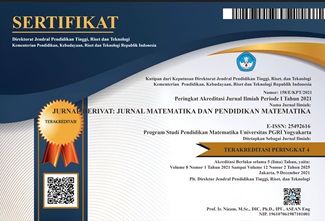Model Sinektik Untuk Meningkatkan Kemampuan Analisis Matematis Pada Siswa MTS Ushuluddin Singkawang
DOI:
https://doi.org/10.31316/j.derivat.v7i1.629Abstract
Abstract
This study aims to determine the improvement of students' mathematical analysis skills, individual and classical learning completeness, and student learning interest in the tangent material of the VIII class MTs Usshuludin Singkawang by applying the Synectic learning model. This study uses a Quasi-Experimental design using the Nonequivalent Control Group form, the population in this study are all classes of VIII MTs Usshuludin Singkawang consisting of 5 classes totaling 149 people. The sample was taken using the Random Sampling Cluster technique, while the sample consisted of two classes, namely class VIII B (29 students) as an experimental class and class VIII D (30 students) as a control class. The data analysis technique used was the 1 sample t-test to calculate individual completeness, the proportion test to calculate classical completeness, the two independent sample t-tests to calculate differences in mathematical analysis ability improvement, and the one variable t / z test to calculate student interest in learning. The results showed: 1) There was mastery learning both individually and classically that got direct learning using synectic models, 2) There was a difference in the improvement of students 'mathematical analysis skills, the increase in the experimental class was higher than in the control class, 3) The students' interest in learning after being applied to learn using synectic learning models can reach more than 70% of the ideal value.
Â
Keywords: Synectic Learning Model, mathematical analysis ability, mastery learning, student interest in learning
References
Daswa. 2013 . Penerapan Model Pembelajaran Sinekik Untuk Meningkatkan
Kemampuan Berfikir Kreatif dan Komunikasi Matematis Siswa Madrasah Tsanawiyah. Tesis Universitas Pendidikan Indonesia
Depdiknas. (2016). Peraturan Mentri Pendidikan Nasional Republik Indonesia Nomor 021
Tahun 2016 tentang Standar Isi untuk Satuan Pendidikan Dasar dan Menengah. Jakarta:
Kemendiknas.
Detesyani, A. (2017). Pengaruh Model Pembelajaran Sinektik Terhadap Kemampuan
Koneksi Matematik Siswa (Bachelor's thesis, FITK).
Harimukti, R. Kemampuan Analisis, Evaluasi, dan Kreasi Siswa SMP Nuris Jember Dalam
Menyelesaikan Soal Pisa Berdasarkan Kemampuan Matematika.
Huda, M. (2013). Model-model pengajaran dan pembelajaran. Pustaka Pelajar
Istiyani, Lusi Anita. 2016. Deskripsi Kemampuan Berfikir Analitis. Jurnal FKIP UMP
Marini . 2014 . Analisis Kemampuan Berfikir Analitis Siswa dengan Gaya Tipe Investigasi
dalam Pemecahan Masalah Matematika. Artikel Ilmiah Mahasiswa FKIP Universitas Jambi
Sapitri, Y., Utami, C., & Mariyam, M. (2019). Analisis kemampuan pemecahan masalah
matematis siswa dalam menyelesaikan soal open-ended pada materi lingkaran ditinjau dari minat belajar. Variabel, 2(1), 16-23.
Rahmatin, Fikri Adi. 2013. Studi Komperasi Pembelajaran. Skripsi FKIP UMP
Suprijono, A. (2009). Cooperative learning: teori & aplikasi PAIKEM. Pustaka Pelajar.
Suria. 2015. Penerapan Model Pembelajaran Reciprocal Teaching Untung Meningkatkan
Kemampuan pemecahan Masalah Matematis Siswa Pada Materi Program Linear Kelas X
SMK. Proposal Skripsi STKIP Singkawang
Khotimah, N., Utami, C., & Prihatiningtyas, N. C. (2018). Penerapan Model Learning Cycle
E Untuk Meningkatkan Kemampuan Literasi Matematis Siswa Kelas VIII Pada Materi Prisma. JPMI (Jurnal Pendidikan Matematika Indonesia), 3(1), 15-20.
Winarti. 2015. Profil Kemampuan Berpikir Analisis dan Evaluasi Siswa Dalam Mengerjakan
Soal Konsep Kalor. Yogyakarta: Jurnal Inovasi, Volume 2 Nomor 1 Mei 2015
Yuli, Neyliya. dkk. 2015. Model Pembelajaran Group Investigation (GI) Terhadap
Kemampuan Berfikir Analitis. Jurnal Universitas Negeri Malang
Downloads
Published
Issue
Section
Citation Check
License
Authors who publish with this journal agree to the following terms:
-
Authors retain copyright and grant the journal right of first publication with the work simultaneously licensed under a Creative Commons Attribution-ShareAlike 4.0 International License that allows others to share the work with an acknowledgment of the work's authorship and initial publication in this journal.
- Authors are able to enter into separate, additional contractual arrangements for the non-exclusive distribution of the journal's published version of the work (e.g., post it to an institutional repository or publish it in a book), with an acknowledgment of its initial publication in this journal.
- Authors are permitted and encouraged to post their work online (e.g., in institutional repositories or on their website) prior to and during the submission process, as it can lead to productive exchanges, as well as earlier and greater citation of published work (See The Effect of Open Access).







